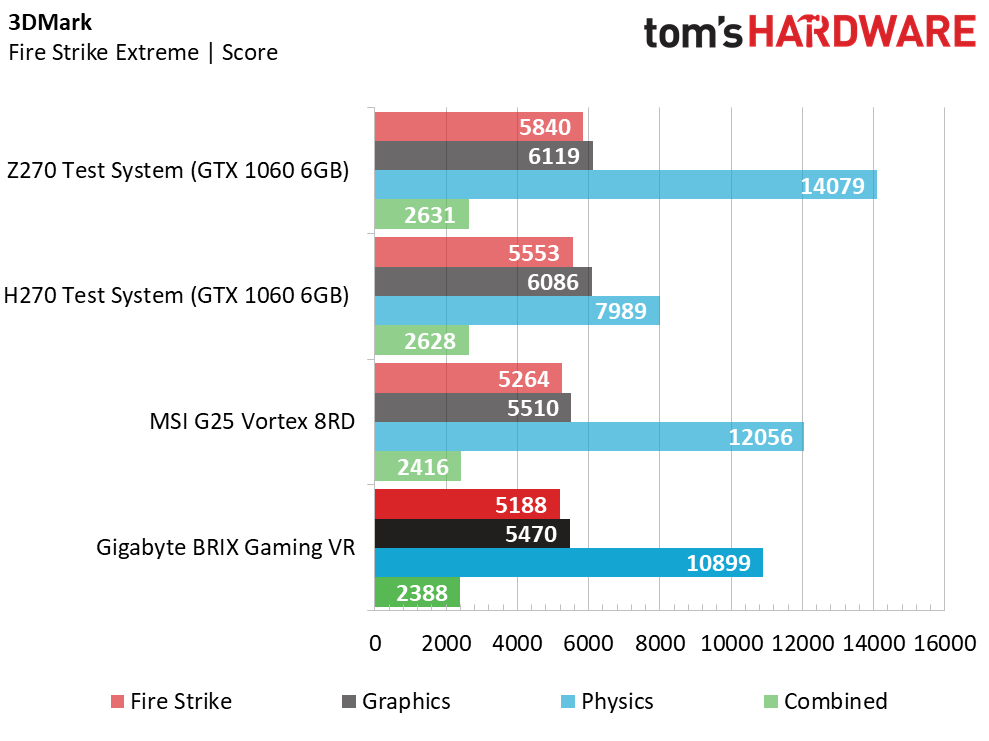Gigabyte BRIX Gaming VR Barebones Mini PC Review
Why you can trust Tom's Hardware
Synthetic & Productivity Benchmarks
We compared Gigabyte's Brix Gaming VR to the recently reviewed MSI G25 Vortex 8RD, which also features a custom MXM GeForce GTX 1060 6GB graphics card and delivers a desirable small form factor. It uses an Intel Core i5-8400 CPU. The Gigabyte Brix Gaming VR also falls into the same sub-$1500 price point as the Vortex (after you add storage, memory, and an operating system). We also made a new H270 platform equipped with an Intel Core i5-7500 and an ASRock H270 Performance motherboard to see how a similarly equipped desktop with a locked CPU would perform against Gigabyte’s sample with a locked mobile CPU. You can see the full specifications of our H270 test platform below.
Comparison Products
H270 Test System Configuration
We also tapped into the data from our Z270 test bench, which is equipped with an Intel Core i7-7700K clocked at the default frequencies. We anticipate the Brix Gaming VR should fall in line somewhere between the two reference systems in CPU-intensive tasks. Both of our desktop reference systems were tested with a Zotac GTX 1060 6GB mini graphics card, which sports Nvidia’s stock clock rates. This should provide an adequate baseline to compare with Nvidia’s mobile counterparts.
Z270 Test System Configuration
For these barebones system reviews, we used the same set of storage and memory for testing. This includes an 8GB (2 x 4GB) kit of G.Skill SO-DIMM DDR4-2133 memory with a CAS latency of 15-15-15-35 and a 256GB Toshiba OCZ RD400 M.2 NVMe SSD. Since these components affect a variety of our synthetic benchmarks, we excluded our usual Storage and Memory Bandwidth results, as they will vary based on what the end user ultimately chooses to put in a barebones PC. These parts will also affect productivity workloads where memory bandwidth and storage speed is a factor, but we still chose to include these metrics because we are using the same set of components across all of the barebones PCs we test.
3DMark




The Gigabyte Brix Gaming VR performs in the same ballpark as its similarly equipped desktop competition in the 3DMark Fire Strike and Time Spy benchmarks, but it falls noticeably behind its direct competition, the MSI G25 Vortex, in the graphics portions of the tests. This is likely the result of lower peak GPU clock rates, with the Brix throttling back to the base clock rate fairly often thanks to temperatures reaching up to 85°C. However, the Gaming VR manages to net better CPU performance than our H270 test rig (equipped with a Core i5-7500), and it narrowly trails the Vortex's Core i5-8400, showing that Intel's 8th-generation, six-core desktop CPU has better multi-core performance chops than the previous generation's mobile i7 offering.
Cinebench R15
With CPU performance under the microscope in the Cinebench R15 benchmark, the Gigabyte Brix Gaming VR performs similarly to what the 3DMark CPU tests laid out, lagging behind the pack in single-threaded and OpenGL workloads. Again, the Gaming VR bests our H270 reference system in the multi-threaded portion of the test, with the hyper-threaded quad-core i7-7700HQ under the hood beating the Core i5-7500's four cores.
CompuBench
The Gigabyte Brix Gaming VR clearly has a slight GPU disadvantage compared to the G25 Vortex, falling behind the MSI-branding competition in the CompuBench Video Processing and Bitcoin Mining tests. Although the margin is small, it continues to point out a performance gap between Gigabyte's MXM GeForce GTX 1060 6GB graphics card and MSI's custom MXM card.
PCMark 8
Performance in the PCMark 8 application benchmarks are a mixed bag of results for the Gigabyte Brix Gaming VR. It falls significantly behind the other GTX 1060-equipped PCs in the field in the Adobe Creative test, but it manages to outpace the H270 reference system in the Microsoft Office application workloads. Storage and memory-intensive workload performance (especially Adobe software) will vary depending on what you install in your barebones Brix, but we can confidently say that the Gaming VR performs slightly behind other options.
Get Tom's Hardware's best news and in-depth reviews, straight to your inbox.
PCMark 10 Extended
The PCMark 10 Extended results give us a more varied look at specific productivity workload performance, and the Gigabyte Brix Gaming VR is able to finally lift itself out of the bottom slot in the chart by outperforming our H270 reference system. The Brix Gaming VR still falls behind the H270 rig (and other GTX 1060-equipped PCs) in the Gaming test, but a close score in the Essentials benchmark, and comfortable leads in the Productivity and Digital Content Creation portion of the test gives the Brix a higher overall score. Again, our particular storage and memory setup has a significant impact on this, and your choice of hardware may prove better or worse in these particular workloads.
VRMark
VRMark tells a similar gaming performance story. The Gigabyte Brix Gaming VR falls behind the desktop GPU-equipped competition and the MSI G25 Vortex 8RD. However, the Brix exceeds the minimum recommended performance for the Oculus Rift in the Orange Room test. Pushing the detail settings higher with the Blue Room test crushes all of the GTX 1060-equipped systems in the field.
MORE: Best PC Builds
MORE: How To Build A PC
MORE: All PC Builds Content
Current page: Synthetic & Productivity Benchmarks
Prev Page Introduction & Product Tour Next Page Gaming BenchmarksDerek Forrest was a contributing freelance writer for Tom's Hardware. He covered hardware news and reviews, focusing on gaming desktops and laptops.
-
Pompompaihn It's neat but it's not far off, and perhaps even ABOVE the price of a full 1060 gaming laptop, and that'll come with the OS, RAM, and some kind of cheap hard drive....and, oh yeah, as screen. Just hook it up to your TV when you want to game large.Reply
I'm sure there's a niche market for it....but it seems awful pricey for what you're getting.






